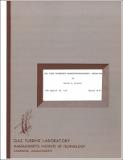| dc.contributor.author | Oliver, David A. (David Anthony), 1939- | en_US |
| dc.contributor.other | Massachusetts Institute of Technology. Gas Turbine Laboratory | en_US |
| dc.date.accessioned | 2016-10-06T21:22:01Z | |
| dc.date.available | 2016-10-06T21:22:01Z | |
| dc.date.issued | 1974 | en_US |
| dc.identifier.uri | http://hdl.handle.net/1721.1/104694 | |
| dc.description | March 1974 | en_US |
| dc.description | Includes bibliographical references (page 24) | en_US |
| dc.description.abstract | Introduction: Low magnetic Reynolds number magnetohydrodynamic generators as would be utilized in power plants are conceived of as steady state D.C. devices. Unsteady phenomena may exist in such generators however. Fluctuations induced fluid mechanically or through combustion may develop into amplifying magnetoacoustic instabilities. In addition to possible instabilities appearing in the bulk of the flow, there exist other important unsteady situations in which the generator must operate. These include the transient response of the generator to changes in load conditions, start up and shut down, coupled unsteady interactions of the generator with the power grid, and the response of the generator to faults such as electrode wall break down or the sudden imposition of a short along the insulator wall. Many of these unsteady situations involve large changes in the amplitudes of the fluid mechanical and electrical variables and therefore require a large amplitude unsteady theory. | en_US |
| dc.description.abstract | In the present work we present a description of unsteady quasi one dimensional magnetohydrodynamic generator flows and propose a highly accurate explicit time dependent method of predicting the time response of such flows. This method of calculation is capable of treating MHD flows under subsonic, supersonic, and transonic flow conditions, arbitrary nonuniformities in electric fields and currents, strong interaction parameters, and with normal shocks present in the duct. In Part II a formulation of the appropriate magnetohydrodynamic fluid equations for quasi-one-dimensional flow is given. In Part III a description of the Lorentz forces and Lorentz power in the flow is given. In Part IV a finite difference operator for the unsteady nonlinear MHD equations is proposed and its stability and accuracy characteristics are described. | en_US |
| dc.description.abstract | In Parts VI and VII, illustrations of this analysis are presented for two unsteady generator situations of contemporary interest: (1) the growth and evolution of large amplitude magnetoacoustic fluctuations under conditions of strong interaction, and (2) the behavior of the generator to changes in loading. | en_US |
| dc.description.sponsorship | This work was supported by the National Science Foundation under Grant GK-38130 | en_US |
| dc.description.sponsorship | Supported by the Office of Coal Research, U.S. Department of the Interior | en_US |
| dc.format.extent | 30 pages | en_US |
| dc.publisher | Cambridge, Mass. : Gas Turbine Laboratory , Massachusetts Institute of Technology, [1974] | en_US |
| dc.relation.ispartofseries | GTL report #115 | en_US |
| dc.subject.lcc | TJ778.M41 G24 no.115 | en_US |
| dc.subject.lcsh | Magnetohydrodynamic generators | en_US |
| dc.title | The time dependent magnetohydrodynamic generator | en_US |
| dc.type | Technical Report | en_US |
| dc.identifier.oclc | 09871262 | en_US |
